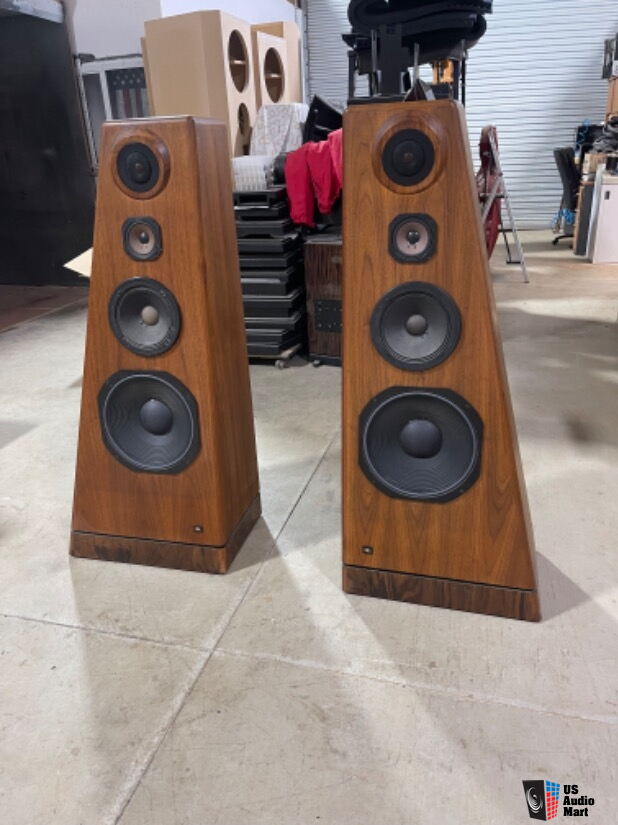Any pics?
Do Your Speakers have LEVEL CONTROLS or EQUALIZERS? (Vintage or Modern) ???
Do Your Speakers have LEVEL CONTROLS or EQUALIZERS? (Vintage or Modern)
MANY Vintage Speakers had/have Level Controls, and a few big speaker arrays had external equalizers.
..............................................................................
Many of you know It’s my contention ALL SPEAKERS should have Level Controls, to refine their frequency distribution in your space at your positioning in that space, and re-adjust for any space you move/use them in.
L-Pads retain impedance shown to the crossover; Potentiometers alter what is shown to the crossover a bit.
......................................
Just stumbled about these
|
2 Altec Lansing speaker crossovers N800-8K |

https://www.ebay.com/itm/313970394857





JBL’s

Bose 901

 .................................................
.................................................
My Uncle’s 1958 Fisher President II (Large 3 way, horns and big woofer) had/have 2 L-Pad level controls


AT-37’s used in many of their consoles and separates.
https://products.electrovoice.com/binary/AT37%20and%20AT38%20EDS.pdf
PRESENCE: for Mid-Range Horn’s Volume Control, relative to he 15" woofer with no control
BRILLIANCE: for Tweeter’s Horn’s Volume Control, relative to the mid-range.
.......................
My AR-2ax (compact 3 way cones) had/have 2 Level Controls



I just restored 2 pairs for my Office and Garage/Shop Systems
https://www.audiogon.com/systems/10092
..................................
MANY Vintage Speakers had/have Level Controls, and a few big speaker arrays had external equalizers.
............................................................
Do Your Speakers have LEVEL CONTROLS or EQUALIZERS? (Vintage or Modern)
- ...
- 38 posts total
So, the answer would be "yes" to many (especially vintage) speakers. We do custom performance upgrades to modern and vintage speakers. My standard practice (if the customer is interested in performance) is to bypass the level adjustments and replace with high quality resistors. Measure resistance, verify with RTA, than listen. It may a little trial and error, taking the values up, or down a notch, but Invariably the speaker will sound better in my experience. But, admittedly, the ability to "tweak" the speaker a bit is forfeited in the process. I also find it worth noting that the factory attenuators and knobs remain in place, the speaker still looks "OEM" and it can be reverted to "stock" at any point in the future. I also make it a general practice to bypass protective fuses. These are serious sound de-generators. My rule of thumb is to bypass the fuse(s) IF: a) the driver, diaphragm etc IS replaceable by an OEM (or, better) device, b) the cost is not prohibitive, and c) the customer has had no instances of blowing fuses (maybe some exceptions, but too involved to detail here). If the owner has played the speaker with a high degree of enthusiasm for decades and not blown a fuse, the chances are low (to zero) that damage to a driver will occur in the coming decades. Please keep in mind that it’s not just a fuse. It’s a fuse holder with connections on both ends and a friction contact fit with the fuse. Not the most "audiophilish" approach to best sound quality. But, as mentioned, if the driver/diaphram is irreplaceable or extraordinarily expense, by all means keep those protective devices in place!! |
When I designed my DIY triamplified horn speakers a DEQX DSP was an integral part of the design. I wanted bass folded corner horns back in the corners and midrange and super tweeter horns well out in the room where they could image better. The DEQX corrected the large time difference between the woofers and the mids. The room correction facility, a ten band parametric equalizer, of the DEQX proved to be very useful and beneficial. |
@elliottbnewcombjr Yes, I'm sure the document said that; it would have been a bit of a task to get the user to understand that the correct setting is an interaction with the output impedance of the amplifier. You'll notice that by the mid 1970s these controls had all but vanished. Electro Voice and MacIntosh led the way pushing for the speaker to be 'voltage driven'. That eliminated the need for the controls. The Patrician was an amazing speaker. Thanks for the photos.
|
There is a pair of JBL L250’s for sale on US Audio Mart.
bluury, you get the idea, manual explains as ’their most sophisticated ... to date
https://www.audioheritage.org/html/profiles/jbl/l250.htm
They have a sophisticated set of optional level controls, shown in the manual here
|
- 38 posts total




